Friday strikes me as a great day for some Thread Talk, don’t you think?
Today, we’re going to wiggle our toes about in the waters of Wool Threads to get familiar with them, and then we’ll take the plunge into thread comparisons and explorations.
First, I’ll introduce you to my plan for discussing wool threads and talk about them in general. We will look at four popular brands of crewel wool up close and see what’s different about each of them.
Down the road, we’ll go further with stitched samples and comparisons, and then we’ll bring in some lesser-known brands and work with them a bit, too.
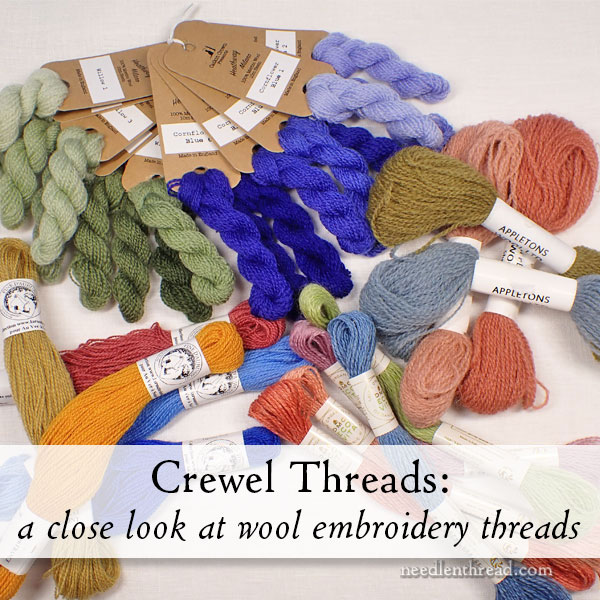
In our first up-close adventure with wool in this series of articles, we’re going to look at four brands of crewel-weight wool embroidery threads: Appletons, Fine d’Aubusson, Heathway (from Catkin Crown), and the new Eco Vita line from DMC.
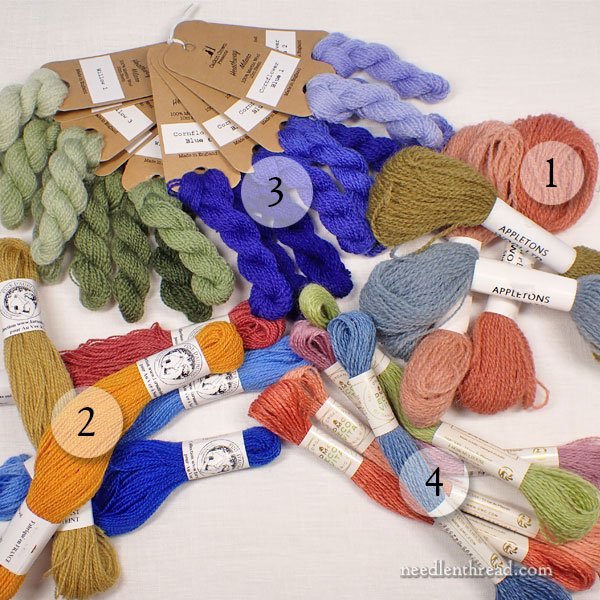
1. Appletons has been around for a long time – well over 100 years. It hails from the UK, where it is grown on the backs of sheep in Yorkshire, spun, dyed, and distributed from Buckinghamshire to the rest of the world.
The skeins I presently have of Appletons wool are a little older – the packaging has changed since I acquired them.
Appletons comes in a vast array of 425 colors, with lots of shade ranges in the color families. Of all the wools here, it has the widest color range. In the US, the price ranges from about $1.95 – $2.35 for a 25 meter skein of crewel weight wool (around 9¢ / meter).
2. Fine d’Aubusson (I’ve written about this thread here) hails from France, from Au Ver a Soie (the silk thread company).
Fine d’Aubusson (which I call FDA) is 100% merino wool and it comes in 120 colors. The skein is made up of a 4-thread bundle (so you can use just one of the four threads) of 8 meters, which works out to 32 total meters of thread. In the US, the common price range I’m seeing is about $3.75 – $4.12 / skein (around 12¢ / meter).
3. Heathway hails from the UK, from Catkin Crown Textile Studios. It is a 100% Merino wool, with a color range around 180 threads (approximately 20 color families, with up to 9 shades in each color family).
The small skeins (they are actually twists) are 10 meters. In the US, they are sold in 10 yard twists, at $3.50 per twist (around 35¢ / meter). You can also order a larger size twist of 100 meters through Catkin Crown Textile Studios.
4. Eco Vita from DMC is the new kid on the block, at least here in the US. I’ve been working with it on this wool embroidery project, which we will get back to a little later.
Eco Vita is an organic naturally dyed wool that comes in a range of 60 colors. It comes on a 16 meter (17.5 yard) skein, and here in the US it costs about $1.79 / skein (about 10¢ / meter).
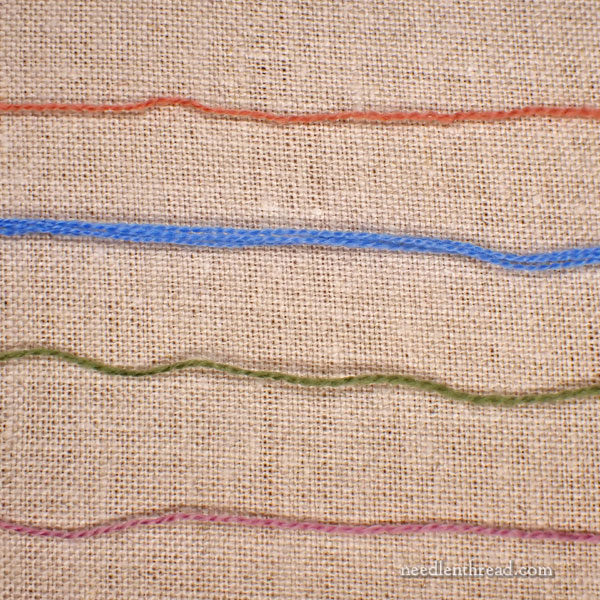
From top to bottom in the photo above, you have Appletons, Fine d’Aubusson, Heathway, and Eco Vita.
When you look at them this way, they tend to look approximately the same weight (or thickness), but there are subtle differences.
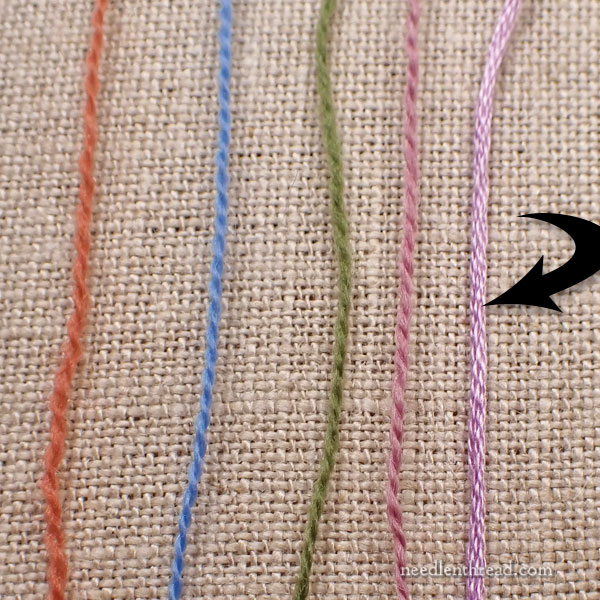
In the photo above, I’ve thrown in some stranded cotton on the right – DMC floss, with all six strands as it comes off the skein. This is just to give you a point of comparison, since most people are familiar with stranded cotton.
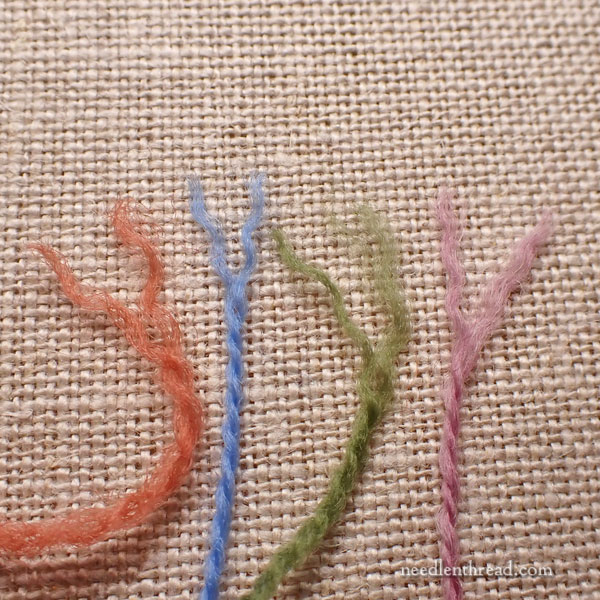
You can’t really judge the weight or thickness of wool embroidery thread the same way you can cotton, though, because it’s completely different stuff.
Crewel wool is a two-ply thread. That means there are two “threads” (plies) of the spun wool that are twisted together to make the one thread that you stitch with. You can’t take these apart – if you do, the strength of the thread falters and you’d end up with a jolly fuzzy mess if you tried to stitch with it.
Crewel wool tends to be very soft and springy, so when you stitch with it, it spreads more (meaning it covers faster, with less yardage). Only under tension can really judge the coverage of the wool, though.
It might look fat and springy when it’s just cut off the skein, but once you stitch with it, adding tension to it, it thins up a bit.
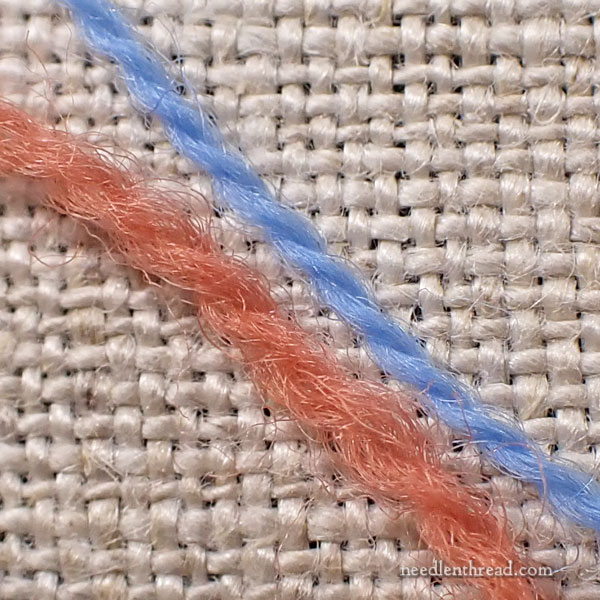
Above, we’re looking at the cut threads that haven’t been stitched. They are not under any tension – they’re just lying on the fabric.
The orange thread in the photo above is the Appletons and the blue thread is Fine d’Aubusson.
When you look at these two threads close up, you can see that FDA is a much finer wool thread with a tighter twist compared to the Appletons.
The Appletons also looks decidedly fuzzier, looser, and thicker.
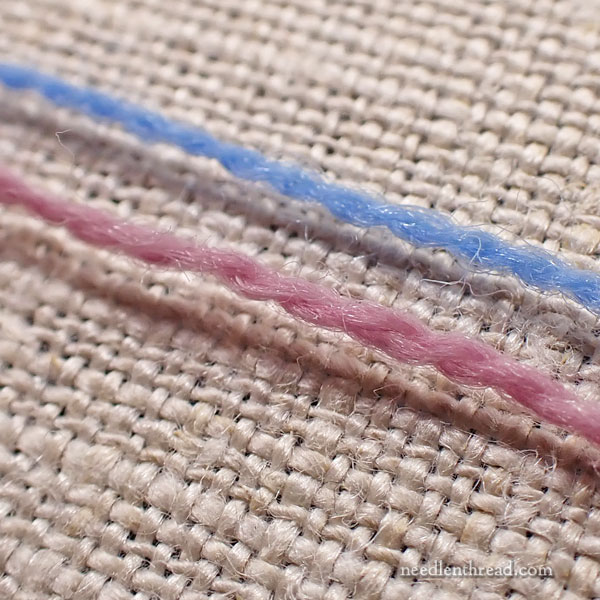
Up close here, you can see the Fine d’Aubusson (blue) with the Eco Vita (pink).
The FDA (blue) has a tighter twist than the Eco Vita, but the Eco Vita almost looks as fine as the FDA, as far as thickness goes.
It isn’t, though. There’s a lot more fiber in those looser twists on the Eco Vita, which will result in a heavier twisted line.
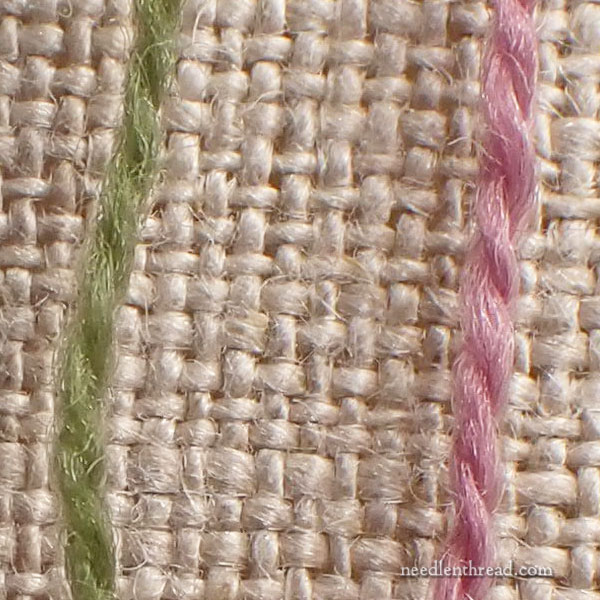
Here, you can see the Eco Vita (pink) with Heathway (green). From this photo, they might again look similar in thickness, but not quite the same.
A Hitch
When considering the “size” or thickness of wool thread, there’s a little hitch: under tension, when the threads are stitched, they pull in quite a bit. They aren’t necessarily as thick as they seem when they are just cut off the skein and are lying loose.
Putting them under tension pulls in all the fibers that are loose and somewhat bouncy and makes them more compact. This a very noticeable thing with many wool threads. Fine D’Aubusson, though, is somewhat of an exception. It doesn’t have as much “boing” as the other wools we’re talking about here, and the fibers aren’t as loose.
We will see all this when we stitch with these wools a little bit later.
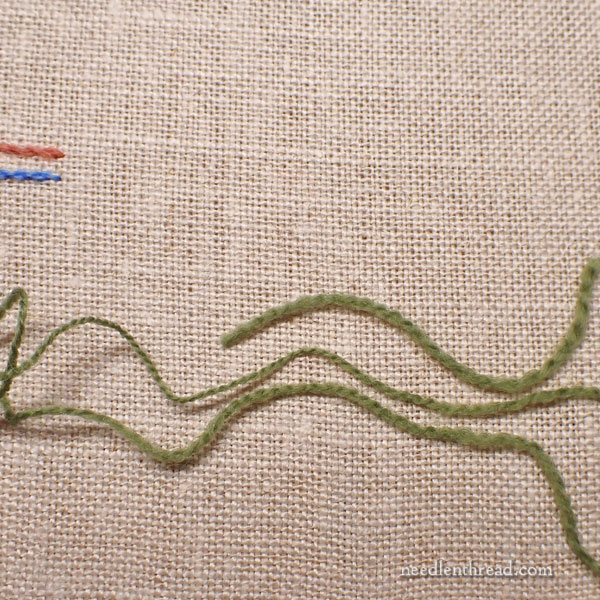
While all wool threads occasionally have some variation throughout the thread (some threads have decidedly less variation than others – Fine D’Aubusson being the most consistent out of the four we’re looking at here), I noticed that the Heathway thread has quite a bit of variation throughout any given twist.
The thread in the photo above is just lying on the fabric. It’s one continuous thread that’s resting in a serpentine path.
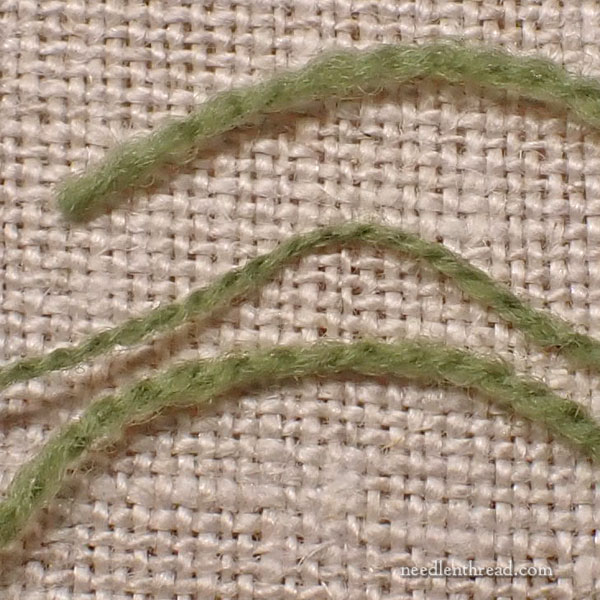
Up close, you can really see the variation in “thickness” in this thread.
I’m wondering about this. Is this because it’s put up in a twist, so the thread is under tension in different areas of it, with twisting and folding? I’m not really sure. I suspect it’s just the nature of the thread and the way it’s made.
The upshot is, to really compare the weight or thickness of these wool threads, you have to see them stitched up.
And to that end, the next time we visit this topic, we will line up the threads next to each and stitch them in a couple different ways.
At that point, we will have a better sense of the thread: 1) we’ll see the “thickness” of the thread when it’s actually in use; and 2) we’ll experience how the thread behaves as we stitch with it.
And that, my friends, is coming up next time, when we talk about wool embroidery threads!
In Other News
We’ve restocked needle minders and have a really nice selection of them right now. We still have a few Purple Posy kits available, if you’ve not grabbed yours yet. We’ve added more stock for the pre-order of Hardanger Filling Stitches, if you’d like to get in on that pre-order. We hope to be shipping those next week! And finally, we have a few more copies of Life in Seasons available, too. You can find all this here in the shop.
We will be stitching the sides of Purple Posy next week, so keep an eye out for that!
And yes, I’m still planning on a chat about linen very soon! I have some special linens to show you, including a new one that’s really lovely.
All that, and other bits and bobs, coming soon!
Have a lovely weekend!







Thank you for all the wonderful information. I was wondering if you had heard of any crewel threads grown and or manufactured in North America. Also, can one substitute a laceweight knitting yarn?
There is a wool yarn – Array wool – that’s made here in the US. It’s primarily sold for weaving, but has recently made its way into the embroidery world. I have some that I’m testing. It doesn’t behave completely like the crewel wools that I’ve been writing about, but there are pros and cons to it that I’ll discuss once I get to the point of writing about it. Shouldn’t be too long now!
A very interesting comparison Mary, thank you. Looking at the four you have chosen to compare, I wondered whether you’ve ever used Renaissance Dyeing’s crewel wool?
Heathway Milano is my favourite crewel wool, and I was surprised to see the difference in thickness along the thread as in my experience it’s a lot more even than Appleton’s (which I had to use for the RSN Certificate but which I rather dislike – it sometimes contains hard, black or white fibres, it feels much less soft than HM or Renaissance Dyeing and can be very variable in thickness). Do you find this variation in thickness in several of the skeins you got from HM, or just this one?
Hi, Ilke! Keep in mind that the photos I’m taking are super up close. If you were seeing that thread normally, you might notice a slight difference, but the difference wouldn’t seem quite as extreme. When viewing close up in a photo, the difference is much more noticeable. I’ve seen the differences in more than one skein.
I do like Renaissance Dyeing! I haven’t bought any recently – it’s been years – but I do have some on hand still. I haven’t used it all up just yet. 🙂
“Boing” this is the official term now, I love it.
I enjoy doing crewel embroidery. I choose the thread to match the effect of the finished project. Jacobean crewel is one of my favorite and to me the fuzzy, hairier look fits well with the style of Jacobean. And I appreciate the large range of colours. For other projects I use the smoother, silkier merino wool.
This is one of (many!) reasons I love Mary’s site, she’s the investigative reporter of embroidery! I mean, where else can you find this kind of information? And because I’m a visual learner – as many of us are – I find these detailed photos incredibly helpful. Thank you, Mary!
I also have a question: you used to have a page of products available on Amazon that you use and sometimes recommend, but haven’t been able to find that link. Is that still around?
Thanks!
Bonnie
Hi, Bonnie, Thanks!! And thank you for asking – yes, my Amazon recommendations page is here: https://www.amazon.com/shop/marycorbet
Thanks again!
Bella Lusso is also a beautiful embroidery wool. It can be purchased in skeins or hanks, depending on how much of any one color is needed.
Thanks, Teresa! Yes, we’ll be looking at Bella Lusso in the next batch. It’s such a soft, lovely, smooth wool. I used it on my Crewel Rooster some eons back and wrote about it then. I keep thinking I’ll return to it for a project or two… some day!
Can’t wait to see them stitched. I’ve never worked with wool that I know of. I have some thread from late 80’s to early 90’s that I would love to know what kind it is. I used some to cross stitch sheep and the sheep is wooly looking. Much better than the Rainbow Gallery Wisper thread. The thread I have came with a Pretty Punch kit (punch needle) and amazingly it did not shred or break being so old. I still want to see how it looks in surface embroidery but haven’t had time to try it. I love the extra texture on the little sheep I did. I did see packs on Ebay for sale and the package states it’s an embroidery acrylic yarn, which I never heard of except in the set I have.
Now a topic near and dear to my heart. Wool. First of all Appleton’s wool is all sourced from Yorkshire, which means it can be any kind of sheep, of any age. Just like your own hair, sheep wool changes due to age. Because it comes from a wool pool, where all the farmers bring in their fleeces, it can be different from year to year. Some years I have to use two strands of Appleton’s to get the same coverage.
Merino all comes from just a single type of sheep. Better for the long term health of sheep for there to be many types of sheep being bred. Although Merino is my favorite to stitch with, it isn’t the best for anything that gets hard wear, like footstools.
Traditional crewel work from the 17th century came from a longer, medium to coarse wool. Definitely the wool was not as fine as today’s longwool sheep.
The crewel wool you get today is mostly two ply, spun clockwise and plyed counterclockwise and not meant to be separated. The finer your linen, the finer your wool needs to be. Wool without much boing is better for weaving and embroidering with.
Yup, I am a farmer. I raised Merinos, Cotswolds, and Romney. Love those sheep!
Oooooh, I love sheep farms, Holly! I grew up next to one. And my sister and her family had a small one in PA until very recently, when reduced their flock to three remaining Jacobs (and four donkeys). There’s nothing better than the sound of sheep in the morning. I love it!
Thank you for showing us about wolltread. In Denmark we use Florawool. Good wooltread from fru Zippe.
Great to read this study of crewel wools Mary. I’m interested in the new ones and will try the Eco Vita which I had not heard of before reading this. You could also try Renaissance wools which have a lovely strong smooth but solid tension and great for mid 17th Century red work or blue work. Also good for replicating early American crewel work. Thank you this is such good information.
Thanks, Phillipa! Yes, I really love Renaissance Dyeing wools – I’m so relieved that they are still offering them after Andie moved on from the business. They are beautiful threads, and a great color line-up. I’ve written about them frequently over the years.
Hi Mary,
I am really enjoying all the info about wool threads. You cover all bases and you make them great for understanding. I appreciate you taking the time and care. I looked up the Eco Vita thread and DMC sells a 30 thread set. The price is reasonable. I wish there was a full set to purchase. It is so hard to pick and choose! Oh what a problem to have.
Hi, Susy, I’ll be stocking those sets shortly, too. They’re on their way. I’ll also have a kit available in the near future, with a nice, but smaller, selection of the colors. 🙂
Dear Mary,
thank you so much! Your description is really helpfull for the decision what wool to buy.
I‘m very curious about your next post.
Thank you , very interesting. Will wait for the stitching episode to see the results.
Great post, thank you. What’s your opinion on the best way to store crewel wool? I’ve done a few kits now and have a lot of leftovers.
I would not store it closed up in plastic (like ziplocks), but I would store it so that it is dust-free and out of the light. I store mine in a cabinet, in drawers for the most part. I do have some in plastic tubs, but they are not airtight tubs.
In fact, if you do store them in ziplocks, punch holes in the ziplocks. I have some threads stored in bags, and I just punch holes in the bags so that there is some air circulation.
Hello. I don’t see any mention of 3-ply crewel thread in your various articles on thread, but I am looking for a supplier of such thread. I learned how to embroider at school when I was 10 (1965), and my mother used to buy me Erica Wilson embroidery kits at a local (Bethesda, MD) sewing shop, now long gone. I recently purchased a never-opened Erica Wilson embroidery kit on e-Bay, which I have enjoyed embroidering, but it doesn’t contain enough thread (nor identify the thread maker/supplier). I’d like to purchase more thread in specific colors as they are named in the embroidery kit. Any suggestions? Thank you.
She used a tapestry wool that you can break down and separate. It’s a heavier wool, not your typical crewel weight, if I recall correctly from the older kits I’ve seen. I am not aware of a three-ply crewel wool. You might look up Paternayan wool, as it was very commonly used back then.
Very informative article, Mary.
I’m on an intermediate level and have only used cotton thread on linen, so I know nothing about using wool thread.
I would like to see the various wool you’ve discussed actually stitched to see the difference. I understand that will be demonstrated in an upcoming article.
I saw a book on wool embroidery on Etsy and am thinking of buying it because it is devoted to various flowers, which have a life-like quality, and I like the added dimensionality with the wool thread.
I wonder if one can use a combination of cotton floss and wool floss on the same project (For example, adding a flower in wool thread for effect to a piece on linen with mostly with cotton floss)?
Thanks, Marith
Sure you can! I’ve seen cotton and wool in the same project – and wool and silk, too, which is a lovely combination. There are really no “rules” that you say you “can” or “can’t” do this or that with embroidery. If you like the way it looks, then why not?